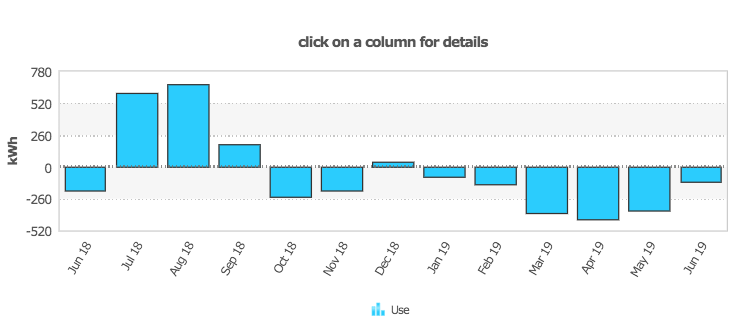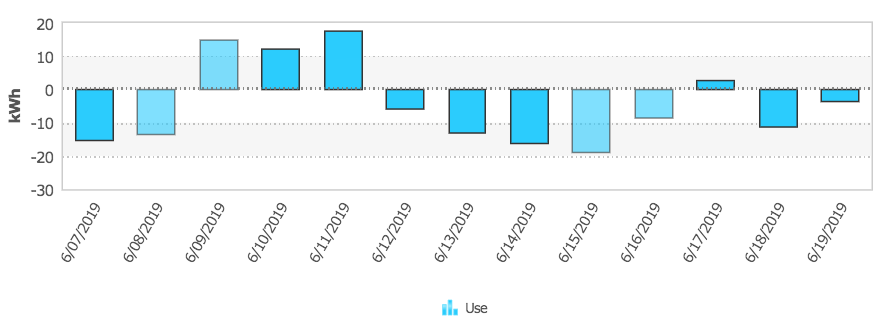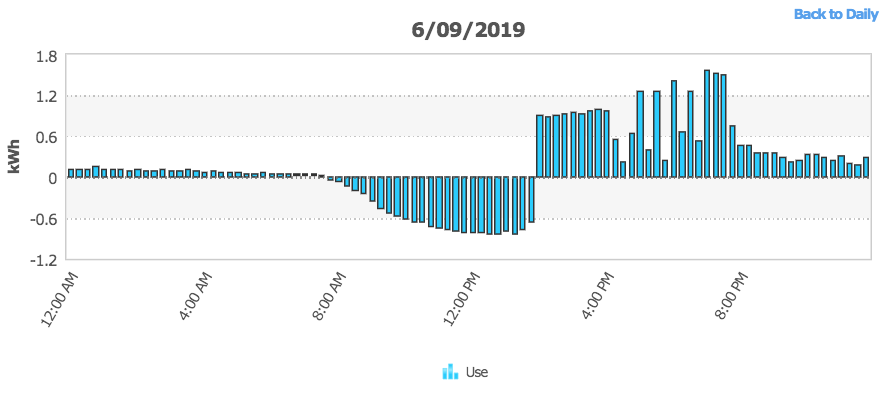How solar panels work
To understand net energy metering, AKA net metering, first, you must know that the electricity generated by solar panels has to go somewhere. It goes into your plugged-in things like the refrigerator, pool pump, AC, or whatever else is on during the day. If electricity doesn’t go into devices, it may go into a battery storage system or back to the electric grid. One way or another, the electricity has to go somewhere.
If the electricity doesn’t go somewhere in your home, it goes back to the electric grid; enter net metering.
How net metering works
Net metering gives you a monetary credit for each unit of electricity your system produces but isn’t used or stored in your home. The more electricity you make but don’t use, the greater the balance becomes in your favor. During three months in 2018, from July to September, you can see below how the home used more electricity than the system generated, offset by the surplus electricity generated by the solar panels during the rest of the year.

Net metering for annual generation
Below is a window showing a much shorter time frame, 13 days, wherein the home used more electricity than the system generated. These surplus credits start to accumulate into a positive balance in your account.

Net metering solar generation month to date
The previous two graphs show the annual and monthly electricity use or surplus. In the graph below, you can see the bell curve of electricity generation. As the sun rises, the home’s electricity usage becomes an electricity surplus from the solar panels on the roof. As the sun moves into the optimal position, electricity generation peaks at about 12:30-1:00.
All that surplus electricity was sent back to the electrical grid, and that user’s utility account was credited with monies in their account. If you compare the graph below for 6/15/2019 to the above, you can see how the 15th generated a significant surplus of power.

Net metering daily solar generation
In the graph below, for 6/09/2019, you can see how the electricity generation bell curve was interrupted at about 2:00. What happened there is that the AC units powered on as the day got hotter. If you compare this graph to the monthly chart above, see how on 6/09/2019, there was an overall electricity deficit. Instead of billing the customer’s account, the utility company debits its previous solar generation credits.

Net metering solar generation applied to heavy usage
How am I charged for electricity with net metering?
San Diego Gas & Electric, Southern California Edison, & Pacific Gas & Electric have unique nuances for net metering. Solar generation and electricity usage depending on the time of year plus current weather, so it would be too difficult and impractical to reconcile the utility bill monthly. As is the case before installing solar panels. As such, utilities will bill you once a year. Case in point, below you can see the current monetary balance of $405.12 for the account tied to the above graphs. The date on which the system is turned on is also the close-out for balancing out the electricity your system generated for the entire year minus the electricity you consumed. This date is known as the “true-up” date.
This system & utility account belongs to me, and my true-up date is December 11th. From now until that date, I know my family will run the AC, the kids will continue leaving lights on, and my wife will task me with putting up Christmas lights in late November. As a result, we will use the $405.12 below and almost break even. Last year we paid the utility company ~$50 for the entire year.

Net metering current solar balance
How much does net metering pay?
Net metering is a BIG part of how solar works on a financial level and is the primary reason why solar is so prevalent in many states, especially California. In ideal situations, the utility will give you a one-to-one rate for the surplus electricity generated by the system. For example, if the utility charges you .29¢, you’d get paid the same amount for that unit of electricity. If, at the time of true-up, your system generated a surplus of power for the year, then you would, in fact, get a lower rate closer to ~.025¢. So it would not make sense to significantly oversize your system compared to your usage unless you plan to increase your power use a lot more after installing solar panels.
Some utilities always pay pennies on the dollar, and some pay zero. Some utilities will settle somewhere in the range of ~.025¢ for annual surplus (at the time of true-up). You can be sure those utilities have very few, if any, customers that have solar installed because without net metering, solar only makes sense; with net metering, it can make dollars.
What does net metering mean to me?
Net metering can mean relief from the high cost of electricity, and the best part is that the cost of solar is less than the cost of electricity. Furthermore, DroneQuote offers an excellent solution for homeowners who want to explore solar but don’t want to sit through multiple sales presentations. If you have been considering solar for your home, head to DroneQuote and request quotes.
Our solar experts will design a system option that fits your needs, walk through different installer quotes on a live webinar, and answer all your questions from the comfort of your home. Get started today so you can install in 2019 before the summer rush and the tax credit decreases.
